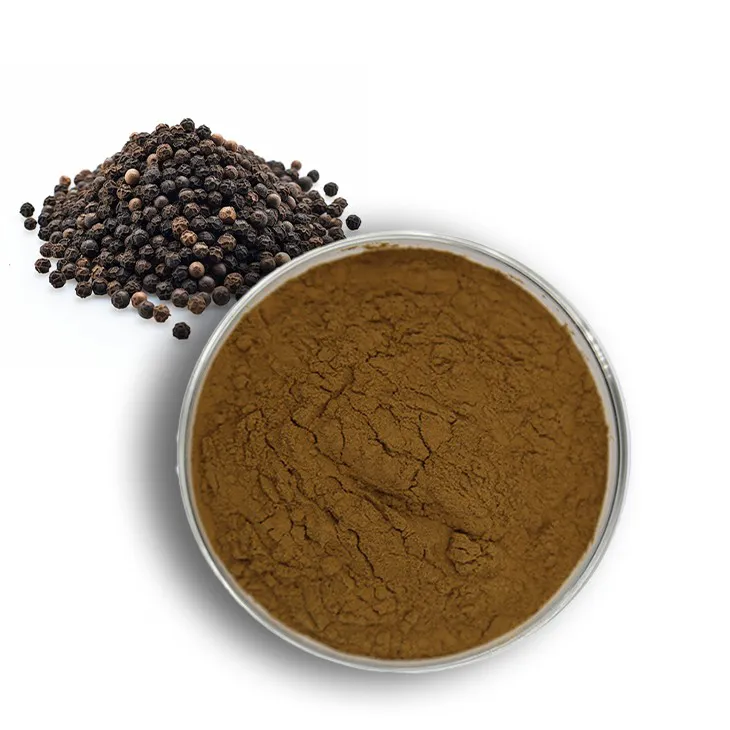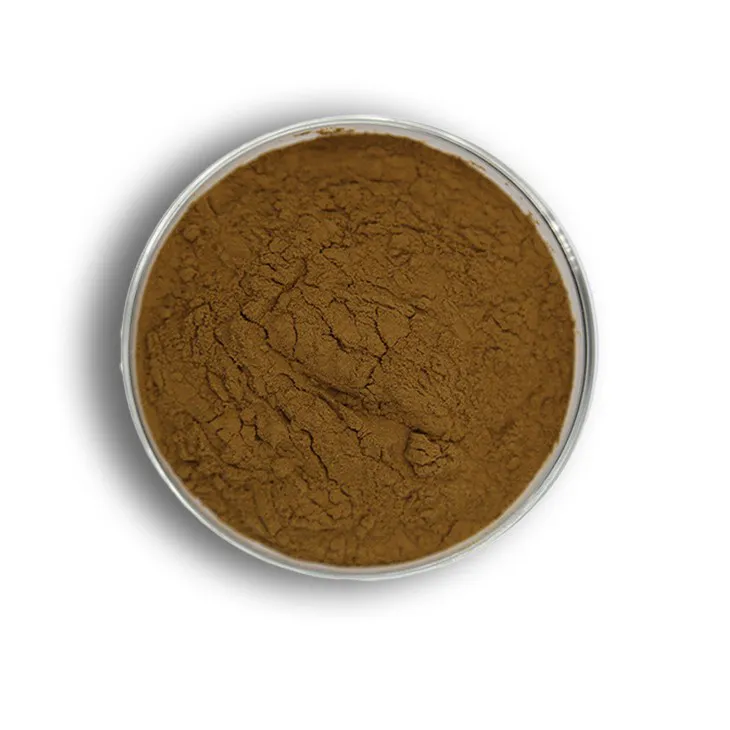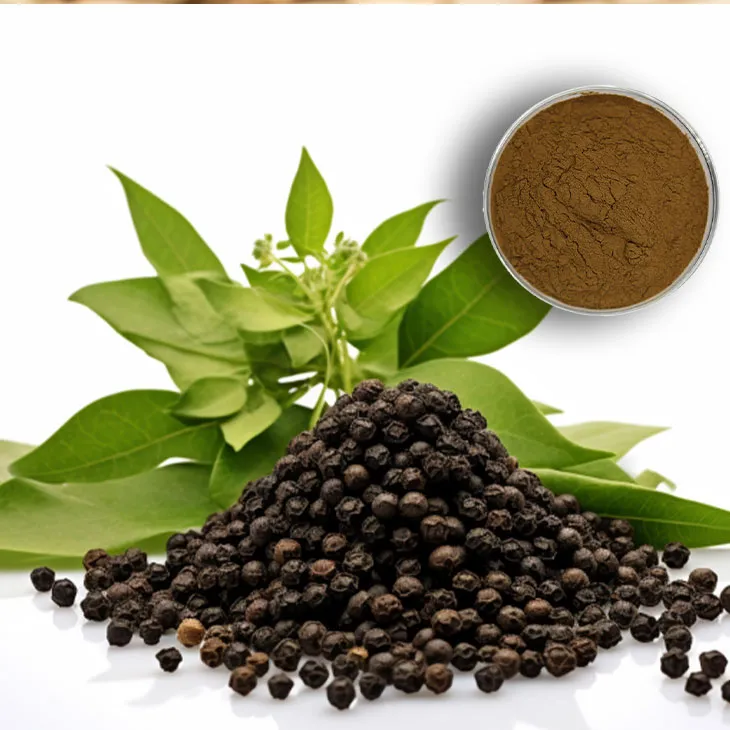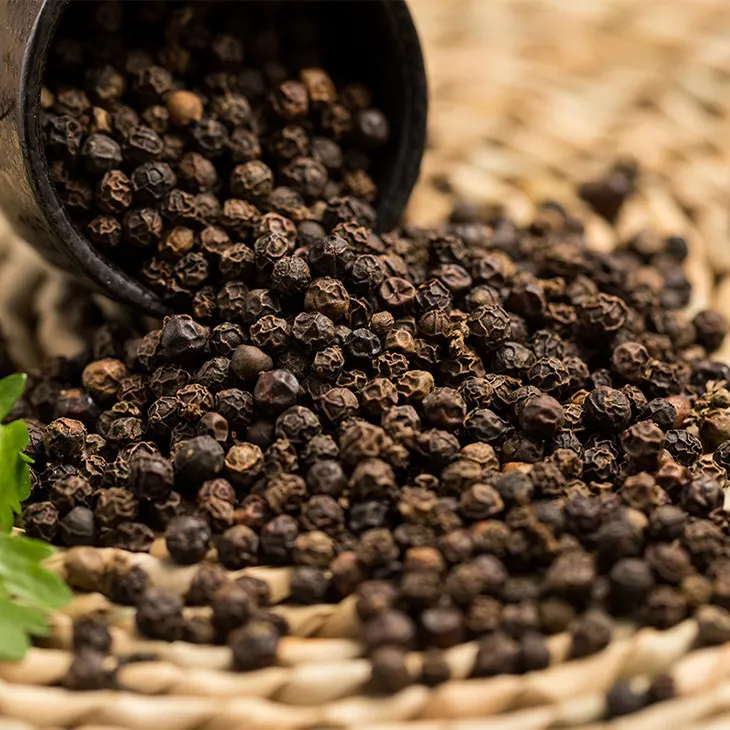- 0086-571-85302990
- sales@greenskybio.com
Extraction technology and production process of black pepper extract.
2024-11-29

1. Introduction
Black pepper (Piper nigrum) is one of the most widely used spices in the world. Black Pepper Extract, which contains various bioactive compounds, has also gained increasing attention in the fields of food, medicine, and cosmetics. Understanding the extraction technology and production process of Black Pepper Extract is crucial for ensuring its quality and maximizing its potential applications.

2. Traditional extraction methods
2.1 Solvent extraction
Solvent extraction is a commonly used traditional method for extracting Black Pepper Extract. In this method, a suitable solvent is selected to dissolve the bioactive compounds from black pepper. Ethanol, methanol, and ethyl acetate are some of the frequently used solvents.
The general process involves grinding the black pepper into a fine powder first. Then, the powder is mixed with the solvent in a certain ratio. The mixture is usually stirred for a certain period, typically several hours to days, at a constant temperature. After that, the mixture is filtered to separate the extract from the solid residue. The filtrate, which contains the black pepper extract, may be further concentrated under reduced pressure to obtain a more concentrated extract.
However, solvent extraction has some limitations. One of the main drawbacks is that it may require a large amount of solvent, which can be costly and may also pose environmental problems. Moreover, some solvents may have potential toxicity, which requires careful handling and purification steps to ensure the safety of the final product.
2.2 Hydro - distillation
Hydro - distillation is another traditional extraction method for black pepper. This method is based on the principle that the volatile compounds in black pepper can be vaporized along with water vapor. The process typically involves placing the black pepper in a distillation apparatus along with water.
The water is heated to boiling, and the steam carries the volatile components from the black pepper. The vapor mixture is then condensed, and the resulting liquid is separated into an aqueous phase and an oil - rich phase. The oil - rich phase contains the black pepper essential oil, which is a part of the black pepper extract. Hydro - distillation is a relatively simple method, but it also has some disadvantages. For example, it may cause hydrolysis or thermal degradation of some bioactive compounds during the long - term heating process, which can affect the quality of the extract.

3. Modern extraction techniques
3.1 Microwave - assisted extraction
Microwave - assisted extraction (MAE) is a modern and efficient extraction technique. In MAE, microwaves are used to heat the black pepper - solvent mixture directly. The microwaves generate heat by interacting with the polar molecules in the mixture, which leads to a rapid increase in temperature.
The process of MAE usually involves placing the ground black pepper and the solvent in a microwave - transparent vessel. The vessel is then placed in a microwave oven, and the extraction is carried out at a specific power and for a certain time. Compared with traditional solvent extraction, MAE has several advantages. It can significantly reduce the extraction time, usually from hours to minutes. It also requires a relatively small amount of solvent, which is more environmentally friendly. Moreover, MAE can often achieve a higher extraction yield and better preserve the bioactive compounds in the black pepper due to its rapid heating process.
However, MAE also has some challenges. One of the main challenges is that the extraction process needs to be carefully optimized to avoid over - heating, which can cause degradation of the bioactive compounds. Additionally, the equipment for MAE is relatively expensive, which may limit its widespread application in some small - scale production facilities.
3.2 Supercritical fluid extraction
Supercritical fluid extraction (SFE) is another advanced extraction technique. In SFE, a supercritical fluid, usually carbon dioxide (CO₂), is used as the extraction solvent. A supercritical fluid has properties between those of a liquid and a gas, such as high diffusivity and low viscosity.
The process of SFE involves pressurizing and heating CO₂ to its supercritical state. The supercritical CO₂ is then passed through the ground black pepper, and it selectively extracts the bioactive compounds. After that, the pressure is reduced, and the CO₂ returns to its gaseous state, leaving behind the extracted compounds. SFE has many advantages. It is a very clean extraction method since CO₂ is non - toxic, non - flammable, and easily removed from the extract. It can also achieve high - purity extracts with good selectivity for different bioactive compounds. However, the equipment for SFE is extremely expensive, and the operation requires high - level technical skills, which restricts its large - scale industrial application to some extent.

4. Factors affecting the production process
4.1 Temperature
Temperature plays a crucial role in the extraction of black pepper extract. In traditional solvent extraction and hydro - distillation, the appropriate temperature needs to be maintained to ensure the solubility of bioactive compounds and the vaporization of volatile components.
For example, in solvent extraction, if the temperature is too low, the extraction rate may be slow, and some compounds may not be fully dissolved. On the other hand, if the temperature is too high, it may cause degradation of heat - sensitive bioactive compounds. In microwave - assisted extraction and supercritical fluid extraction, temperature control is also of great importance. In MAE, over - heating due to improper temperature control can lead to the destruction of bioactive compounds. In SFE, the temperature and pressure are closely related, and any deviation from the optimal temperature - pressure conditions can affect the extraction efficiency and the quality of the extract.
4.2 Pressure
Pressure is a significant factor, especially in supercritical fluid extraction. As mentioned before, in SFE, carbon dioxide needs to be pressurized to its supercritical state. The appropriate pressure is essential for maintaining the supercritical properties of CO₂ and ensuring efficient extraction.
If the pressure is too low, CO₂ may not reach its supercritical state, and the extraction efficiency will be low. If the pressure is too high, it may pose safety risks to the equipment and also may cause some unexpected chemical reactions in the extraction system. In other extraction methods such as hydro - distillation, pressure also has an impact. For example, changes in pressure during the distillation process can affect the vaporization and condensation of volatile components, thus influencing the quality and yield of the black pepper extract.
4.3 Extraction time
The extraction time is an important parameter in all extraction methods. In solvent extraction, a longer extraction time may increase the yield of the extract, but it also increases the risk of degradation of bioactive compounds and may be more time - consuming and costly.
In microwave - assisted extraction, although it generally has a shorter extraction time compared with traditional solvent extraction, the extraction time still needs to be optimized. Too short an extraction time may result in incomplete extraction, while too long an extraction time may cause over - extraction or degradation of compounds. In hydro - distillation and supercritical fluid extraction, the extraction time also affects the quality and yield of the extract. Therefore, finding the optimal extraction time for each extraction method is crucial for obtaining high - quality black pepper extract.

5. Quality control and analysis of black pepper extract
Quality control is essential in the production of black pepper extract. There are several aspects to consider for quality control.
5.1 Chemical composition analysis
The chemical composition of black pepper extract is complex, containing various bioactive compounds such as piperine, essential oils, and phenolic compounds. Analytical techniques such as high - performance liquid chromatography (HPLC), gas chromatography - mass spectrometry (GC - MS), and infrared spectroscopy (IR) are often used to analyze the chemical composition of the extract. These techniques can help identify and quantify the different components in the extract, ensuring that the extract meets the required quality standards.
5.2 Purity and impurity detection
Detecting impurities in the black pepper extract is also important. Impurities may come from the raw materials, solvents, or the extraction process itself. For example, residual solvents in the extract need to be monitored to ensure that they are within the acceptable limits. Heavy metal contamination and microbial contamination are also potential issues that need to be addressed. Various analytical methods, such as atomic absorption spectrometry for heavy metal detection and microbiological assays for microbial contamination, are used to ensure the purity of the black pepper extract.
6. Conclusion
The extraction technology and production process of black pepper extract are complex and involve multiple factors. Traditional extraction methods such as solvent extraction and hydro - distillation have their own characteristics, while modern techniques like microwave - assisted extraction and supercritical fluid extraction offer new opportunities for more efficient and high - quality extraction. Factors such as temperature, pressure, and extraction time play crucial roles in the production process and need to be carefully optimized. Quality control and analysis are essential to ensure the safety and quality of black pepper extract. With the continuous development of technology, it is expected that more advanced and sustainable extraction methods will be developed in the future, further promoting the application of black pepper extract in various fields.
FAQ:
What are the traditional extraction methods for black pepper extract?
The traditional extraction methods for black pepper extract mainly include solvent extraction. In solvent extraction, a suitable solvent such as ethanol or ethyl acetate is used. The black pepper powder is soaked in the solvent for a certain period. Then, through filtration and evaporation processes, the extract is obtained. Another traditional method could be steam distillation, where steam is passed through the black pepper material, and the volatile components are carried along with the steam and then condensed to get the extract.
How does microwave - assisted extraction work in the production of black pepper extract?
Microwave - assisted extraction utilizes microwaves to heat the black pepper sample and the extraction solvent simultaneously. The microwaves cause the molecules in the sample and solvent to vibrate rapidly, which in turn increases the mass transfer rate. This leads to a more efficient extraction process as compared to traditional methods. It can break the cell walls of the black pepper more effectively, releasing the active compounds into the solvent more quickly. Also, it can reduce the extraction time significantly while potentially maintaining or even improving the quality of the extract.
What is the role of temperature in the production process of black pepper extract?
Temperature plays a crucial role in the production of black pepper extract. If the temperature is too low, the extraction rate may be slow as the solubility of the active compounds in the solvent may be limited. However, if the temperature is too high, it may lead to the degradation of some heat - sensitive active compounds in black pepper. For example, certain volatile oils and bioactive substances may be lost or their properties may be altered. Therefore, an optimal temperature range needs to be determined to ensure both efficient extraction and the preservation of the quality of the extract.
How does pressure affect the extraction of black pepper extract?
Pressure can influence the extraction of black pepper extract in several ways. Increasing the pressure can sometimes enhance the solubility of the active compounds in the solvent, leading to a higher extraction yield. It can also force the solvent into the pores and cells of the black pepper more effectively, improving the mass transfer process. However, excessive pressure may also cause some unwanted physical or chemical changes in the black pepper or the extract. For example, it may damage the structure of some bioactive molecules. So, like temperature, an appropriate pressure needs to be maintained for a good - quality extract.
What are the main active compounds in black pepper extract?
The main active compounds in black pepper extract include piperine, which is responsible for the pungency of black pepper. Piperine has been studied for its various potential health benefits such as antioxidant, anti - inflammatory, and bioavailability - enhancing properties. Additionally, black pepper extract also contains essential oils like limonene, beta - caryophyllene, and sabinene. These essential oils contribute to the aroma and may also have their own biological activities.
Related literature
- Black Pepper Extract: Chemical Composition and Therapeutic Applications"
- "Advances in Extraction Technologies for Black Pepper Extracts"
- "The Impact of Production Parameters on the Quality of Black Pepper Extract"
- ▶ Hesperidin
- ▶ citrus bioflavonoids
- ▶ plant extract
- ▶ lycopene
- ▶ Diosmin
- ▶ Grape seed extract
- ▶ Sea buckthorn Juice Powder
- ▶ Beetroot powder
- ▶ Hops Extract
- ▶ Artichoke Extract
- ▶ Reishi mushroom extract
- ▶ Astaxanthin
- ▶ Green Tea Extract
- ▶ Curcumin Extract
- ▶ Horse Chestnut Extract
- ▶ Other Problems
- ▶ Boswellia Serrata Extract
- ▶ Resveratrol Extract
- ▶ Marigold Extract
- ▶ Grape Leaf Extract
- ▶ blog3
- ▶ Aminolevulinic acid
- ▶ Cranberry Extract
- ▶ Red Yeast Rice
- ▶ Red Wine Extract
-
Bilberry Extract
2024-11-29
-
Aguaje Extract
2024-11-29
-
Feverfew Extract
2024-11-29
-
Kelp Extract Powder
2024-11-29
-
Acerola Extract
2024-11-29
-
Red Date Extract
2024-11-29
-
Red Wine Extract
2024-11-29
-
Hedyotis Diffusa Extract
2024-11-29
-
Hops Extract
2024-11-29
-
American Ginseng Root Extract
2024-11-29





















